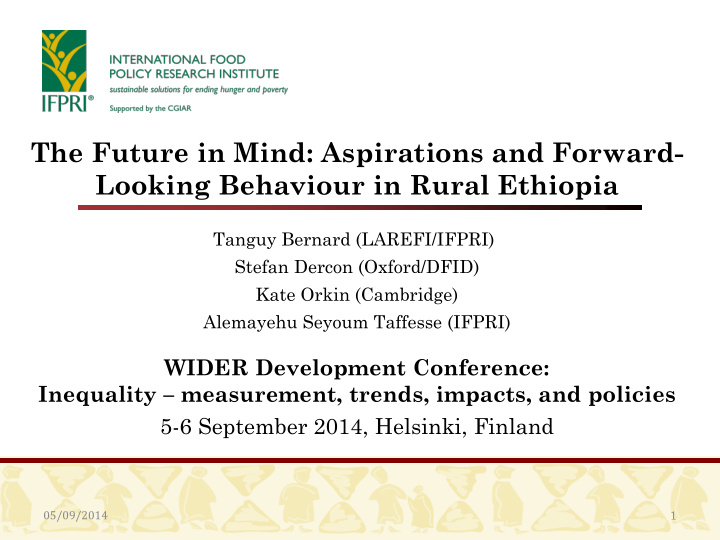



The Future in Mind: Aspirations and Forward- Looking Behaviour in Rural Ethiopia Tanguy Bernard (LAREFI/IFPRI) Stefan Dercon (Oxford/DFID) Kate Orkin (Cambridge) Alemayehu Seyoum Taffesse (IFPRI) WIDER Development Conference: Inequality – measurement, trends, impacts, and policies 5-6 September 2014, Helsinki, Finland 05/09/2014 1
Summary Do people’s aspirations – their goals or preferred end or boundary states with respect to a relevant domain of choice – affect whether they invest? Randomly assign Ethiopian farmers to receive a ‘vicarious experience’ of the lives of four role models. Treatment = one hour of documentaries. No other intervention. Very good balance at baseline across groups Key findings: Improvements in aspirations after screening and after six months. Changes in related psychosocial chartacteristics (LoC), but not risk aversion or time preferences. Small improvements in savings, credit, demand for credit, children’s school enrolment and spending on schooling 6 months after screening . , 05/09/2014 2
Outline Motivation Aspirations Field experiment – design and findings Report on the direct effects on aspirations; Summarize results related to beliefs, preferences, and future- oriented behaviour 05/09/2014 3
Motivation – why do poor people underinvest? Underinvestment by the poor – a source of persistence in poverty and inequality Conceptual – ‘ opportunities ’ Focus 1 - ‘ external circumstances ’ and ‘ opportunities ’. Low returns to investments; Unexploited opportunities due to lack of information or knowledge; Social constraints; Focus 2 - constraints associated with the manifested attributes of decision makers Identity issues: sense of self; Psychological issues : impatience, commitment, and psychological barriers Aspirations failure perspective 05/09/2014 4
What are Aspirations? Aspirations: are goals or boundary-states sought after with respect to a relevant domain of choice ( future-oriented) ; Aspirations and expectations – preferences vs. beliefs ; Aspirations are important for analysing and/or addressing poverty: Condition individual behaviour and well-being ( motivators ); Are distributed unevenly within communities; Are context-dependent and changing; 05/09/2014 5
Specific Question Is it possible to alter poor individuals’ understanding of the opportunities they face by actively trying to change their aspirations using an experimental design in a real-world setting? Measure aspirations; Introduce an exogenous shock aspiration; Estimate impact on aspirations, correlates/determinants, and behaviour; 05/09/2014 6
Experimental design: individual treatment 64 villages. Random selection of 6 treatment HH, 6 placebo HH, 6 control HH. Head and spouse treated. 3 arms: Treatment : ticket to view mini-documentaries about similar people who were successful in small business or agriculture. No other intervention. o 4 x 15 minute documentaries (2 men, 2 women) = 1 hour in Oromiffa o Examples on CSAE Oxford YouTube channel o Placebo : local Ethiopian TV show in 15 minute segments. Control : surveyed at their home. 3 rounds of data collection: baseline (Sept-Dec 2010), aspirations immediately after treatment, follow-up six months later (Mar-May 2011). 05/09/2014 7
On going experiment 05/09/2014 8
Measures of aspirations Four dimensions: Annual income in cash Assets: house, furniture, consumer goods, vehicles Social status: do villagers ask advice Level of education of oldest child Aspirations vs. Expectations : What is the level of ___ that you would like to achieve? What is the level of ___ that you think you will reach within ten years? Overall aspiration index: 𝑙 − 𝜈 𝑙 𝑏 𝑗 𝑙 𝐵 𝑗 = � w 𝑗 𝜏 𝑙 𝑙 𝑙 = individual 𝑗 ’s aspiration response to dimension 𝑙 . 𝑏 𝑗 𝑙 = weight individual 𝑗 assigned to dimension 𝑙 . 𝑥 𝑗 𝜈 𝑙 , 𝜏 𝑙 = village sample mean and standard deviation for dimension 𝑙 . 05/09/2014 9
Specification 𝑙 − 𝜈 𝑙 𝑏 𝑗 𝑙 𝐵 𝑗 = � w 𝑗 𝜏 𝑙 𝑙 𝑙 = individual 𝑗 ’s aspiration response to dimension 𝑙 . 𝑏 𝑗 𝑙 = weight individual 𝑗 assigned to dimension 𝑙 . 𝑥 𝑗 𝜈 𝑙 , 𝜏 𝑙 = village sample mean and standard deviation for dimension 𝑙 . 05/09/2014 10
Results Small treatment effects on aspiration immediately (about 20% of SD). No placebo effect; After screening (t=1) Aspirations Expectations 0.13 * 0.13 * 0.12 * 0.12 ** 0.12 ** 0.11 ** Treated individual 0.07 0.07 0.06 0.06 0.05 0.05 Placebo individual 0 0 0 0.02 0.03 0.03 0.03 0.03 0.03 0.04 0.04 0.03 Village F.E. Yes Yes Yes Yes Yes Yes No Yes Yes No Yes Yes Lagged outcome Controls No No Yes No No Yes Respondents 1959 1957 1957 1959 1954 1954 05/09/2014 11
Results Small effects on aspiration after 6 months (about 3-5% of SD); No placebo effect; Hypothesis that the treatment effect right after screening is the same as the effect after six months – not rejected. After six months (t=2) Aspirations Expectations 0.04 * 0.04 * 0.03 * 0.06 *** 0.06 *** 0.05 ** Treated individual 0.02 0.02 0.02 0.02 0.02 0.02 Placebo individual 0.03 0.02 0.03 0.02 0.02 0.03 0.02 0.02 0.02 0.02 0.02 0.02 Village F.E. Y es Yes Yes Yes Yes Yes Lagged outcome No Yes Yes No Yes Yes Controls No No Yes No No Yes Respondents 2063 2058 2058 2062 2054 2054 05/09/2014 12
Observations Watching documentaries about role models improves • aspirations compared to a control group and, in some cases, compared to a placebo group. Driven by those with above-median aspirations at baseline. – No changes in risk aversion and time preferences. – Improvements in individuals’ sense that they control their lives – ( LoC, causes of poverty ). Small effects on ‘forward-looking behaviour’ - children’s • school enrolment, spending on schooling, hypothetical desire for credit - that are robust to multiple testing ( NP ). Effects on savings, credit are not robust to multiple testing. – Suggestive evidence that peer effects may reinforce • individual effects ( NP ). 05/09/2014 13
Thank you 05/09/2014 14
Recommend
More recommend